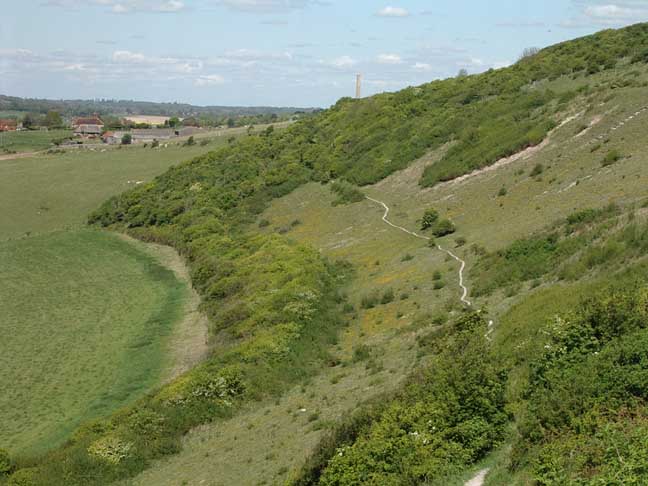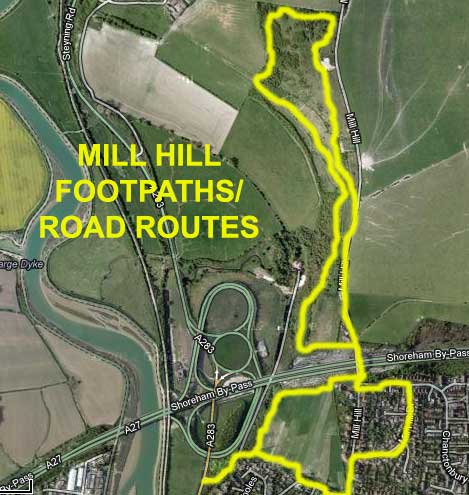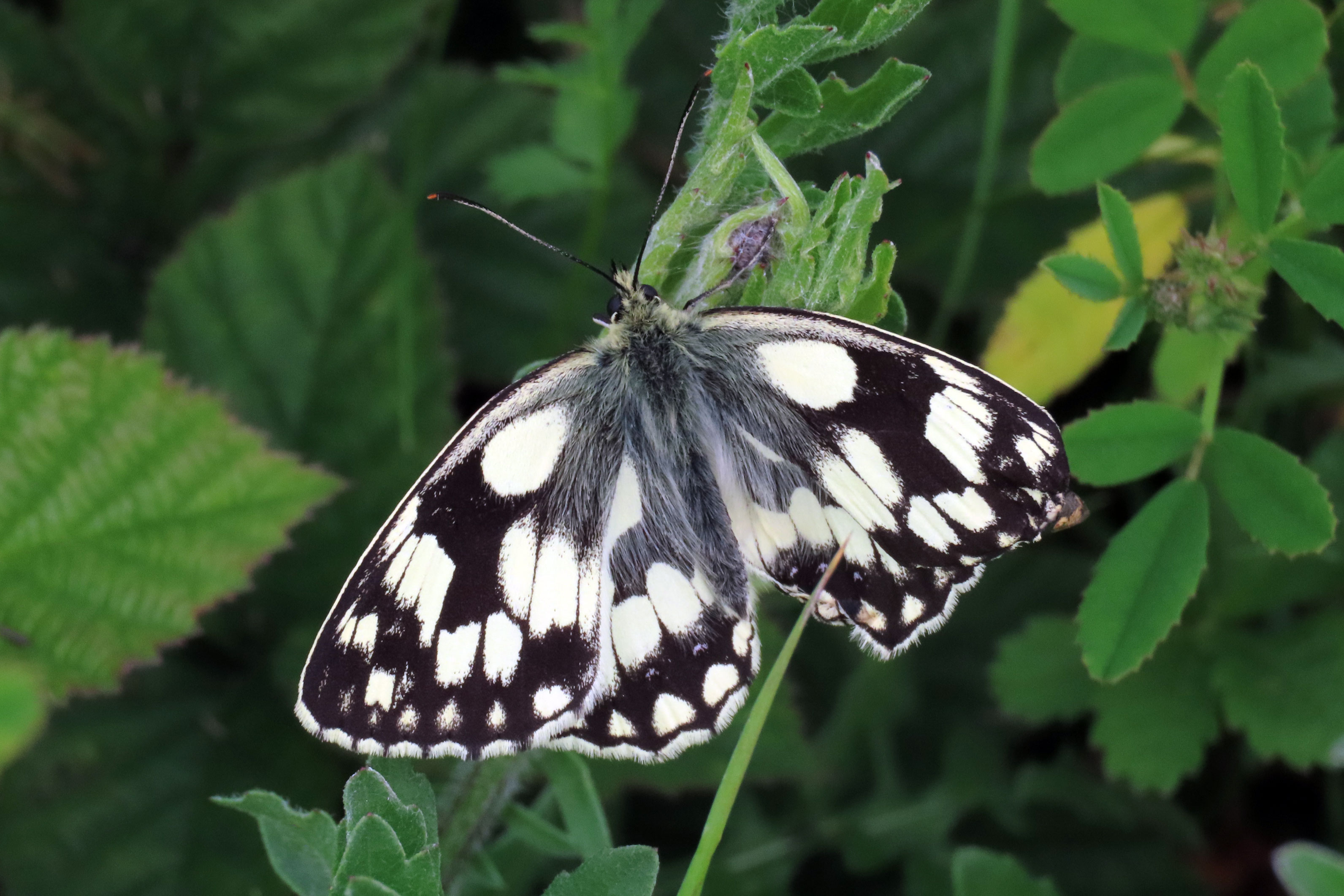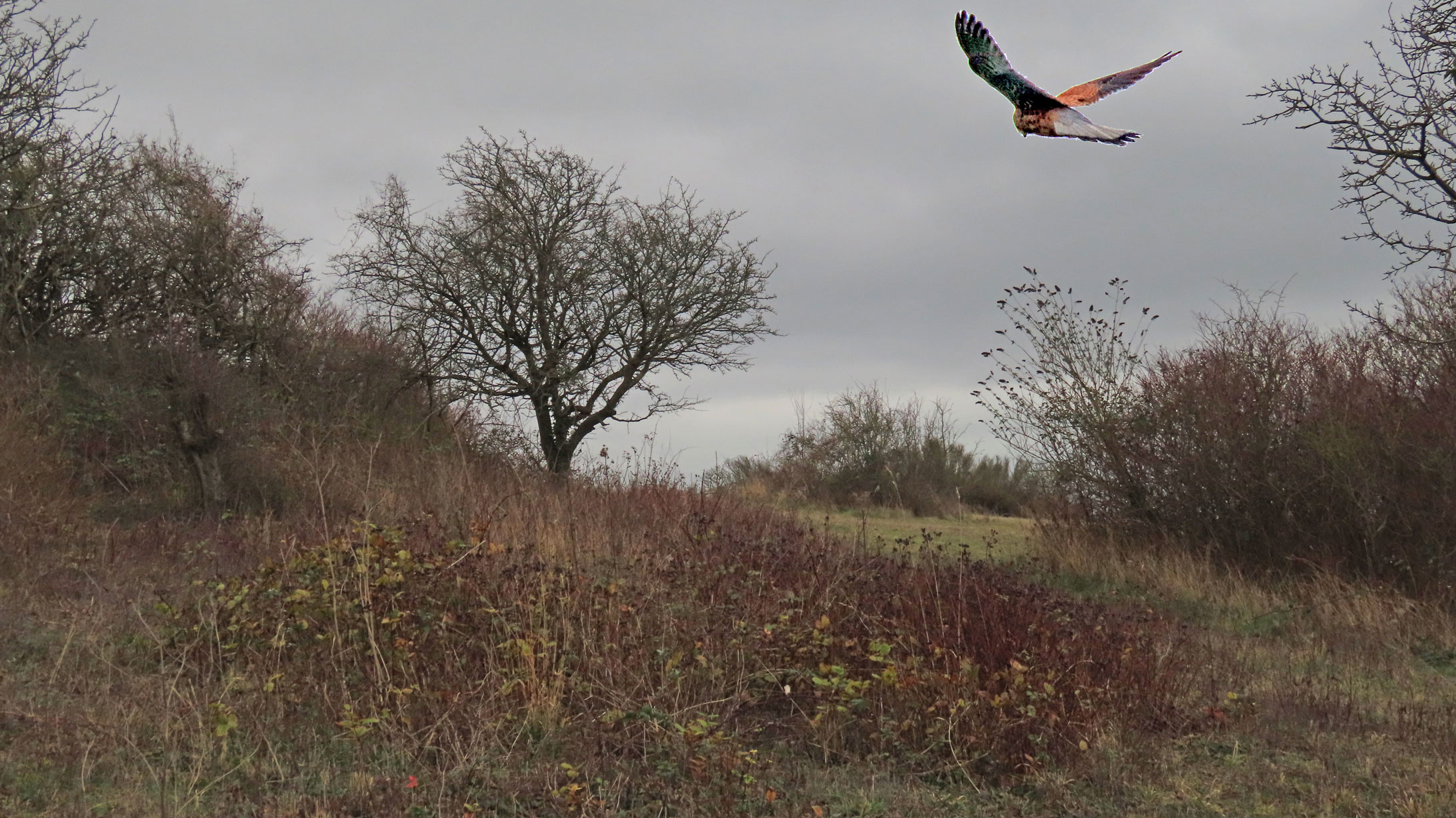
- MILL HILL & the DOWNS
- WILDLIFE REPORTS 2022

 |
 |
 |
 |
|
|
|
|
|
Noticeable
summer plants of the upper meadows include
Greater
Knapweed, Hardheads (=Lesser Knapweed),
Field
Scabious, Meadow Cranesbill, Alexanders,
Pyramidal
Orchids,
Plantains,
Melilots,
Meadow Vetchling, Yarrow,
Eyebrights,
Musk
Thistles,
Hounds-tongue*,
Perforate
St. John's Wort*, Great Mullein*
and
many others. Herb Robert is
found amongst the scrub.
(*notably
on disturbed ground.)
Some Indicator
Plants of Ancient Downland
 |
 |
 |
 |
|
|
|
|
|
Other
indicators on the lower slopes include Dropwort,
Autumn
Ladies Tresses (upper plateau), Hairy
Violet,
all
of which are rarely found on pastures, restored wildlife meadows or agricultural
downland. Other downland plants that are more likely on the biodiverse
down herbland are Wild Thyme,
Carline
Thistle, Dwarf Thistle, Squinancywort,
Fairy
Flax, Small Scabious,
Common
Centaury and
Wild
Basil. There are other more widespread
wild plants like the Mouse-eared Hawkweed,
Rough Hawkbit, Lesser Hawkbit, Bird's Foot Trefoil, Ground
Ivy, Germander
Speedwell, Field Speedwell, Sweet Violet,
Self-heal
and Yellow Wort.
Wild
Flora and Fauna on Chalk flickr
Adur
Wild Flowers 2022
| OVERVIEW:
A large part (724 acres) of the downs including Mill Hill were presented to the people of Shoreham in 1937. Just over 30 acres still remain as public open land and a Local Nature Reserve. This is divided into about 11 acres of grassland and meadows above the ridge, about 9 acres of scrub, the copse and glades at the northern end, and about half of the prime Chalkhill Blue area of 6.4 acres of herbland remaining. 6 acres has been lost to a Sycamore woodland on the southern slopes. This is low fertility chalkland not suitable for grazing. The top area is effectively a wild meadow and the lower slopes a rabbit warren dominated by prostrate (not the upright form) Horseshoe Vetch, Hippocrepis comosa. |

Horseshoe Vetch |
||||||
| Chalkhill Blues:
Mill
Hill is nationally important because of its population of Chalkhill
Blue Butterflies. Estimates of the numbers
are notoriously inaccurate. In the 1950s
the population was estimated by R. M. Craske
to
be 50,000. This may be an exceptionally good year. I would estimate the
numbers at that time to be nearer 25,000 for Mill Hill only. After the
cattle grazing and thorn incursions the numbers plummeted to the most reliable
estimate in 1960
of 6,000. The new road and Sycamore woodland further denuded the Horseshoe
Vetch, Hippocrepis comosa,
and bare chalk downland to a figure I have estimated at a top figure of
3,000 Chalkhill Blue Butterflies at the turn of the millennium (counted
in 2003). Almost
all these butterflies are now to be found on the six acres of the lower
slopes.
|
 |
||||||
| "Our
family lived at The Mill House, Mill Hill, from around 1933
until about 1967, and every July we saw the
"Butterfly Men" walking past onto the Downs. My father used to tell
us that they were interested in the blue butterflies."
Heather
Clark (née Eager), Ryde, Isle of Wight
|
Nearest
Postcode: BN43 5FH
Grid Ref: TQ 21170 07444 (upper car park) Geographic Link OS Map Google Earth Map Magic Map of Mill Hill NR Local Nature Reserve Designation Natural England: Local Nature Reserves Multi-Map (Bird's Eye View) Grid Reference Finder |
FEATURE:

 |
The butterfly lower slopes at Mill Hill are under serious threat by a natural process known as ecological succession where the woody shrubs like Privet, Brambles and Hawthorn invade the herb-rich slopes gradually turning the downs into woodland and eliminating the butterfly larval food plants especially the Horseshoe Vetch, Hippocrepis comosa, on which the Chalkhill Blue Butterflies rely. The remedy is by expert professional removal of the Privet on a regular basis. This job is now being undertaken by volunteers. |

 |

flickr |

|
 |
OS
Map
Footpaths at Mill Hill |
3 October
2022
Alas,
my legs felt weak and I was unable to make more than a cursory visit to
the lower slopes of Mill Hill where I spotted a restless Clouded
Yellow Butterfly
in the poor light of a hazy afternoon. A possible Wall
Brown
fluttered in front of my eyes but I was unable to be sure. I was sure of
a strong flying Red Admiral.
I also disturbed a male Common Blue amongst
the long grasses at the top part of the hill south of the reservoir. I
noted frequent Hawkweed Ox-tongue and
my first Devil's Bit Scabious,
but I had to turn back for fear of falling.
14
September 2022
Scores
of hirundines
were spotted flying at low level, at Hawthorn
scrub height, from west to east over Mill
Hill, in the late afternoon about
five o'clock. Over two hundred birds in ten
minutes, flew over more rapidly than usual. They flew so quickly I had
difficulty recognising them to species in the fading light. Most of them
were Swallows
and there were almost certainly some House
Martins as well. I had never seen so many
together before.
Spotted
Flycatcher, Rosehips
Common
Blue Butterfly (fem)
Mill
Hill
Two Spotted Flycatchers were perched on top of some scrub south-west of the top copse, appearing as silhouettes with the sun behind them. It was way past roosting time for butterflies, but I disturbed a few.
7 September 2022
Two young Kestrels windhovered in tandem over a breezy cloudy Mill Hill.
31
August 2022
Two
Clouded
Yellows fluttered over the upper part
of Mill Hill.
Greater Knapweed
24
August 2022
I
was glad to see Clouded Yellows
on Mill Hill,
but I stopped chasing them when a Large
Conehead Cricket, Ruspolia
nitidula, parachuted down in front
of me to pose for photographs.
It is a scarce vagrant from southern Europe.
Another visit to the lower slopes was truncated because of my walking disability with at least one each of Chalkhill Blue, Adonis Blue, occasional Common Blues, a restless Clouded Yellow and two definite Small Whites, frequent Meadow Browns and Small Heaths, the latter two mostly at the top of the southern steps.
Meadow
Brown,
Red
Bartsia
Melilot
Scores of butterflies fluttered amongst the long parched grasses south of the Reservoir on the southern part of Mill Hill, mostly Small Heaths were disturbed. but also frequent Meadow Browns. I also followed a male Common Blue which quickly visited a very small yellow plant which was just about familiar but not often encountered, My first thought it was that it was the Meadow Vetchling, Lathyrus pratensis, which is supported by the grasses. It was probably a damaged Melilot.
15 August 2022
Large White, Silver-spotted Skipper, Adonis Blue
8 August
2022
I
made a brief visit to the warm 23°C,
sunny lower slopes of Mill Hill, where 36 Chalkhill
Blues fluttered continually over a quarter
acre transect. A female
crawled over the Horseshoe Vetch looking to lay her eggs. There were smaller
numbers of
Gatekeepers,
and Meadow
Browns,
a twice seen Silver-spotted Skipper,
and occasional Common Blues,
four male second brood Adonis Blues,
a restless Clouded Yellow
and two Large Whites. A
Kestrel
hovered over the scrub and blue skies of Mill Hill.
Parched Grasses south of the Reservoir
4
August 2022
I
made a cursory visit to a breezy lower slopes of Mill Hill, where about
fifty restless male Chalkhill Blues
fluttered over a quarter acre transect. A female
crawled over the Horseshoe Vetch looking to lay her eggs. There were smaller
numbers of
Gatekeepers,
and Meadow
Browns,
a very clear Silver-spotted Skipper,
and occasional Common Blues,
a few Speckled Woods and
at least one Wall Brown
and one Red Admiral. I
also spotted two of my first second brood Adonis
Blues of 2022,
3 August
2022
A
Kestrel
hovered over the grey cloudy middle slopes of Mill Hill.
Wall Brown
Only a brief visit was made to the upper part of Mill Hill where there were scores of Common Blues, including mating pairs, frequent Gatekeepers, and Meadow Browns, two Wall Browns one Chalkhill Blue and a Large White. I did not look too hard.
1 August
2022
On
what should be the peak period for butterflies
on Mill Hill, I recorded a mere 39 male Chalkhill
Blues fluttering over a half acre transit
of the lower slopes on a sunny humid afternoon, with similar numbers of
Gatekeepers,
and Meadow
Browns,
two
separate Silver-spotted Skippers,
and occasional Common Blues,
a few Speckled Woods and
White
butterflies
and
at least one Wall Brown.
Fleabane,
Carline Thistle, Lesser Knapweed
Dwarf
Thistle, Ploughman's Spikenard
29
July 2022
In
the energy sapping heat I was not fit enough to make it down
to the lower slopes of Mill Hill much past the Holly
Tree beyond the southern steps, Nevertheless,
butterflies
were very frequent and restless in the hazy afternoon sunshine, including
frequent Chalkhill
Blues, frequent Gatekeepers,
occasional
Meadow
Browns,
a few Brimstone Butterflies.
a Clouded Yellow,
a pair of my first of the year Silver-spotted
Skippers, and occasional Common
Blues, Speckled
Woods and White
butterflies
all
in a space about the size of a suburban garden.
Adur
Skippers
Chalkhill Blue Butterflies
At
least two Kestrels
hovered and dived over a parched Mill Hill, silhouetted in the northern
blue sky on a breezy afternoon. About thirty male Chalkhill
Blue Butterflies were restless in the
hazy sunshine over the lower slopes. A mating pair blundered into a spider's
web and the female Wasp Spider
was startlingly quick, subduing the unfortunate female
butterfly in a second, before wrapping it
up in a silken parcel. The male butterfly
escaped.
Wasp Spider feeding on a Chalkhill Blue Butterfly
Two
pristine Wall Brown Butterflies
settled on the winding path. There were frequent Gatekeepers
and Meadow Browns,
a Brimstone Butterfly.
a Red Admiral,
a fresh second brood Dingy Skipper,
and occasional White butterflies
and
6-spotted Burnet Moths
all in the half acre transit.
Adur
Skippers
6-spotted
Burnet Moth on Dwarf
Thistle
Common
Blue Butterfly
Dingy
Skipper
Hidden
amongst the long grasses south of the Reservoir there were frequent male
Common
Blue Butterflies.
| 20
July 2022
My first of the year Clouded Yellow Butterfly fluttered over the top part of Mill Hill in the sunshine in the late afternoon. 13
July 2022
|
.jpg) |
.jpg) |
10
July 2022
5 July
2022
|
22
June 2022
 |
.jpg) |
|
|
|
21
June 2022
A
large bird of prey
cruised leisurely in a low level flight over the New Erringham pastures
adjacent to the southern part of Mill Hill. Unfortunately, it almost immediately
disappeared from sight because of a small undulation of the down. A few
minutes later I saw it again as the bird reversed its direction of flight
to flying west, parallel with the A27
and again out of sight. This time I was able to recognise it as a Red
Kite from its definite forked tail.
The
bright
orange butterfly spotted yesterday
was spotted again, but it flew away so quickly from the meadow south of
the Reservoir, I was again unable to get a clear view of it. It was much
larger than the usual suspects and was most likely to have been a Dark
Green Fritillary. A Cinnabar
Moth was seen amongst the long grasses
in the afternoon, with restless Marbled
White Butterflies and Meadow
Browns.
Previous
Report of a Dark Green Fritillary 2014

Marbled White
20
June 2022
Over
fifty very fresh Marbled White Butterflies
fluttered
around over the lower slopes of Mill Hill in the bright afternoon sunshine,
They were accompanied by frequent Red Admirals
and
Meadow
Browns, occasional Holly
Blues,
Large
Whites,
Small
Skippers, and Small
Heaths. an unconfirmed bright
orange butterfly and a probable Brown
Argus. The trip was truncated because
of my poor health in about what amounted a cursory visit through a path
overgrown by Stinging Nettles.
15
June 2022
My
first Meadow Brown
Butterflies and first Small
Skipper of the year were disturbed in
the area of Mill Hill south of the covered reservoir in the afternoon sunshine.
Grasses
6 June 2022

Knapweed
Broomrape, Wild Mignonette, Greater
Knapweed
Rough
Hawkbit. Common Blue Butterfly
A dozen fresh male Common Blue Butterflies flew over the grassy area of Mill Hill south of the covered reservoir in unfavourable breezy conditions. Knapweed Broomrape frequently appeared in contrasting brown amongst the green.
3 June 2022
Dropwort,
Spotted
Orchid, Bladder Campion
Mill
Hill and nearby
Two
Cinnabar Moths fluttered over the
hedge-lined Mill Hill Road north of the bridge over the A27
dual carriageway.
Adur
Moths
In the afternoon sunshine, the swathes of Horseshoe Vetch, Hippocrepis comosa, on the lower slopes of Mill Hill were about their peak profusion. About fifty (partially counted) male Adonis Blue Butterflies fluttered around restlessly, with just the one possible female. Alas my physical health was limiting on the steep slopes and I could only add a few Brimstones, a dozen male Common Blues, a Small Heath, a Large White, one Dingy Skipper and my first of the year Brown Argus.
9 May 2022
Adonis Blue
A dozen
male Adonis Blue Butterflies visited
the abundant newly flowering Horseshoe
Vetch,
Hippocrepis comosa,
on
the lower slopes of Mill Hill in the early afternoon. These were the first
of the year for me as was a single spotting of a Small
Heath. Other butterflies
seen were 5+ Grizzled Skippers,
10+ Dingy Skippers,
one male Common Blue,
frequent Brimstones,
one fresh Red Admiral
and one Speckled Wood
by the southern steps, plus a few unidentified whites.
A large
patch of scores of budding Hound's Tongue
was noted on some scrub cleared land on the steeper slopes of Mill Hill
above the path. The Horseshoe Vetch
swathes were still over a week from their peak, but they still look diminished
below the path every year. A new to Mill Hill Cichorioid
Daisy was discovered. It looked like
a Beaked Hawksbeard.
The hairiness of this plant could mean it is the first local record of
the Rough Hawksbeard,
Crepis
biennis.
Subsequent
observations point to Beaked Hawksbeard
Crepis
vesicaria. This latter plant
is frequently seen on Shoreham
Beach.
5 May 2022
Mill Hill
My
first Wall Brown Butterfly
of the year fluttered around the long grass south of the Reservoir on the
top part of Mill Hill with occasional
Brimstone
Butterflies. On the middle slopes, I heard
plenty of varied bird song
emanating from inside the scrub. The repertoire of the Chiff-chaff
was recognised. Cowslips
were flowering but they were not
seen amongst the rabbit burrows where they were common in previous years.
Adur
Butterflies 2022
.jpg)
Grizzled Skipper |
26
April 2022
Clambering around the lower slopes of Mill Hill was close to becoming physically impossible for me even in dry weather. Butterflies were frequently seen in the intermittent afternoon sunshine: a few Brimstones, two Small Tortoiseshells, one Peacock, a few Green-veined Whites, occasional first of the year Grizzled Skippers, a handful of Dingy Skippers, and lastly a few pristine male Common Blues for the first time this year. Another butterfly watcher reported a Green Hairstreak. Eight species A dozen Rooks dominated the blue sky. Chiff-chaffs called from the bushes. The Blackthorn blossom had blown away but the first Hawthorn was in flower on the straggly hedge at the bottom of the lower slopes.
|
18
April 2022
A
walk around Mill Hill this morning, north along the lower path and back
south along the upper path. The highlight was a male Ring
Ouzel seen flying briefly around the slope
before disappearing into scrub. Also a Lesser Whitethroat singing loudly
from the top of a bush along the lower path and a Common Whitethroat further
along. Yellowhammers, Goldfinches, Linnets and Dunnock also on the slope.
A Red Kite
drifted over but was harassed by a Crow.
No
butterflies but did see two very dark Adders
basking on a pile of cut grass.
17
April 2022
_.jpg) |
.jpg) |
|
|
|
There
were precious few flowers
on the lower slopes of Mill Hill for a handful of Peacock
Butterflies and two Dingy
Skippers on an Easter Sunday afternoon.
I spotted the first small Horseshoe Vetch,
Hippocrepis
comosa,
flower.
Adur
Butterflies 2022
Adur
Skippers
13 April 2022
Red
Admiral
Mill
Hill Copse
11 April 2022
.jpg) |
12
April 2022
A White-tailed Eagle was forced to land in my Truleigh Hill garden by gulls and corvids harrying it. Report
by Terry Goble on Shoreham
Birding
11
April 2022
|
.jpg) |
25 March 2022 A Robin called stridently from the top of a prominent bush on the middle slopes of Mill Hill, and his potential partner replied from a hidden location amongst the scrub. In difficult viewing conditions another small bird replaced the Robin in the same small tree and this was an immigrant Chiff-chaff. A few white flowers on thorn bushes were the slow start of the Blackthorn, the green leaves on the bushes were the Hawthorn. |
Blackthorn
Yet
to flower on the top of Mill Hill
Chiff-chaff
23 March 2022

Note the Alexanders in the foreground, abundant around Shoreham.
On
my first visit to the lower slopes of Mill Hill in 2022,
Peacock
Butterflies were sparring with a Small
Tortoiseshell, and Sweet
Violets were sparsely scattered mostly
on the steeper slopes above the winding path. By the southern steps, the
first Blackthorn
flowers had just appeared.
Adur
Violets
Adur
Alexanders
19
March 2022
It
was breezy on the top of Mill Hill, where a Peacock
Butterfly was blown about in a Force
5 easterly gusting to Gale Force 7.
14 March 2022
Cherry Plum

Daffodils

Kestrel on Upper Mill Hill
Mill Hill Nature Reserve
Mill Hill Nature Reserve on facebook
Mill
Hill Wildlife Reports 2021 (Link)
Mill Hill Wildlife Reports 2018 (Link)
Mill
Hill Wildlife Reports 2016 (Link)
Mill
Hill Wildlife Reports 2015 (Link)
Mill
Hill Wildlife Reports 2014 (Link)
Mill
Hill Wildlife Reports 2013 (Link)
Mill
Hill Wildlife Reports 2012 (Link)
Mill
Hill Wildlife Reports 2011 (Link)
Mill Hill Nature Reserve on facebook
Identification
of Grasses (Link)
Mill
Hill Grasses
 |
A
Nature
Reserve is defined in Section 15 of
the National Parks and Access to the Countryside Act 1949,
as land managed for the purpose:
(a)
of providing, under suitable conditions and control, special opportunities
for the study of, and research into, matters relating to the flora and
fauna of Great Britain and the physical conditions in which they live,
and for the study of geological and physiographical features of special
interest in the area; or
|
17+
SPECIES OF BUTTERFLIES DEPENDENT ON MILL HILL
FOR BREEDING:
(Estimated
numbers for Mill Hill Nature Reserve only
are in brackets)
| Chalkhill
Blue (3000 +)
Adonis Blue (50 -100) Dingy Skipper (75) |
Small
Heath (250)
Wall Brown (12) Meadow Brown (300) |
Marbled White (50)
Gatekeeper (200) Speckled Wood (>50) Green-veined White (2+) |
Common
Blue (>4000+)
Small Blue (5) Brimstone (8) |
Small
Skipper (>50)
Large Skipper (10+) Grizzled Skipper (20) Brown Argus (>30) Green Hairstreak ( a few) |
The other species may breed on Mill Hill, but there main breeding area will be adjoining fields or slightly further away. e.g. Small Blue (included above), Small Copper, Small Tortoiseshell, Green-veined White, Peacock, Ringlet, Small White, Large White, Comma, Holly Blue, Orange Tip. (=10). There are huge variances each year for most species.
The following are immigrants &/or hibernators: Red Admiral, Painted Lady, Clouded Yellow.
The following have not been positively identified (because of ID difficulties): Essex Skipper. This species is now included for a local field on the Adur Levels within 500 metres of Mill Hill.
(=30)
The
following was confirmed only in 2009:
Green
Hairstreak.
(=31)
The
following was confirmed only in 2014: Dark
Green Fritillary
(=32)
The next one is no longer
found on Mill Hill but were there in the distant (1947) past: Grayling.
The next one has been recorded
near Mill Hill in the middle distance past: White-letter
Hairstreak
(=34)
The
Silver-spotted
Skipper does not appear to ever have occurred
on Mill Hill
The
Silver-studded
Blue has never been recorded from Mill Hill
The Short-tailed Blue was recorded as a single immigrant in 1956.
17
August 2009
A
possible (unconfirmed) Brown Hairstreak Butterfly
was
spotted. A confirmed one was spotted nearby.
2017
Brown
Hairstreak and Silver-spotted
Skipper have been confirmed from Mill
Hill. The first is notoriously difficult to spot and was probably already
there. The skipper
may be a new addition, but it is small and not easy to spot, and there
have now been numerous sightings
Aerial
Map
Lower
Adur Levels (MultiMap) including Lancing Clump and Mill Hill
Horseshoe
Vetch, Hippocrepis comosa
First
Draft of the Article for the Shoreham Society Newsletter